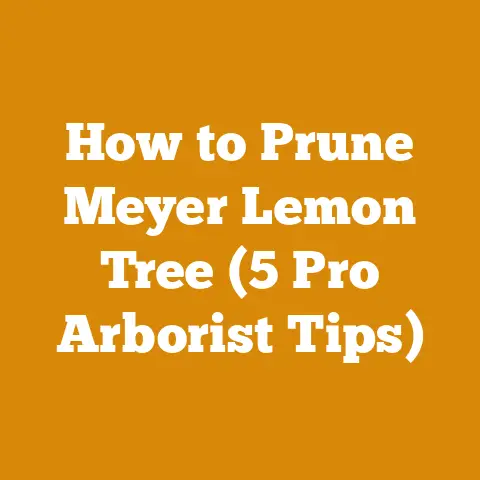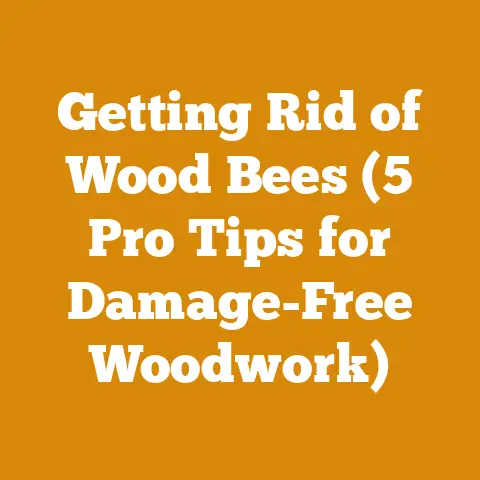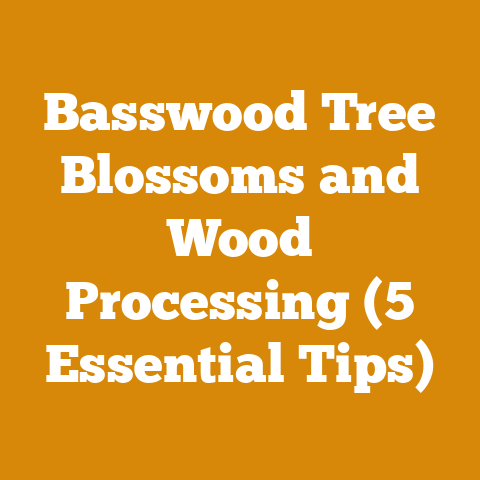Tree Root Fertilizer Insights (5 Pro Techniques for Deep Growth)
Layering, it’s a technique I often use when starting a new garden bed, building up the soil over time. But what if we could apply that same principle to the root systems of our trees, giving them a deep, sustained boost right from the start? That’s the essence of what we’ll be exploring today: innovative fertilization techniques that promote deep, healthy root growth in trees. As someone who’s spent years felling trees, splitting wood, and working with timber, I’ve learned that a tree’s health below ground is just as crucial as what we see above. And just like choosing the right chainsaw for the job, selecting the right fertilization method is key to success.
Tree Root Fertilizer Insights: 5 Pro Techniques for Deep Growth
Getting a tree established, whether it’s a sapling or a more mature transplant, is more than just digging a hole and hoping for the best. It’s about providing the right environment for the roots to thrive and anchor the tree for decades to come. And in my experience, a little extra attention at the beginning can save a lot of heartache (and money) down the road.
Why Deep Root Growth Matters
Before we dive into the techniques, let’s quickly cover why deep root growth is so important. Trees with deep, well-established root systems are:
- More drought-resistant: They can access water deeper in the soil.
- More stable: They are less likely to be blown over in strong winds.
- More resilient: They are better able to withstand disease and pests.
- Healthier overall: A strong root system supports healthy foliage and fruit production.
Think of it like building a house. You wouldn’t skimp on the foundation, would you? The same principle applies to trees.
1. Root Zone Injection: Direct Delivery for Maximum Impact
Root zone injection is like giving your tree a direct IV of nutrients. It involves injecting fertilizer directly into the soil around the tree’s root zone, bypassing the surface layers where weeds and grass might compete for the nutrients.
- How it works: Specialized equipment is used to inject liquid fertilizer several inches below the surface, targeting the active root zone.
- Best for: Established trees that are showing signs of nutrient deficiency, or trees in compacted soils where surface fertilization isn’t effective.
- My experience: I once used root zone injection on a mature oak tree that was struggling after a particularly dry summer. The results were noticeable within weeks – the leaves regained their vibrant color, and the tree showed renewed vigor.
- Cost considerations: The cost of root zone injection varies depending on the size of the tree, the type of fertilizer used, and the local market rates for arboricultural services. Expect to pay anywhere from $50 to $300 per tree. The price will likely increase if you are having this service performed in more remote areas.
- Data Point: According to the International Society of Arboriculture (ISA), root zone injection can increase nutrient uptake by up to 50% compared to surface fertilization.
-
Cost Breakdown:
- Fertilizer: $10-$50 per tree (depending on type and quantity)
- Labor (arborist): $40-$250 per tree (depending on size and accessibility)
- Equipment rental (if DIY): $50-$100 per day. However, given the specialized nature of the equipment, this is generally best left to professionals.
-
DIY vs. Professional: While you can rent the equipment and do this yourself, I strongly recommend hiring a certified arborist. They have the expertise to diagnose nutrient deficiencies accurately and apply the fertilizer correctly, avoiding potential damage to the tree.
- Tip: Look for arborists who use slow-release fertilizers, which provide a more sustained nutrient supply.
2. Deep Root Feeding with Fertilizer Stakes: A Slow and Steady Approach
Fertilizer stakes are solid, slow-release fertilizer formulations that are inserted into the ground around the tree’s drip line. They provide a consistent, long-term supply of nutrients directly to the roots.
- How it works: The stakes dissolve slowly over time, releasing nutrients into the soil.
- Best for: Young trees that are establishing their root systems, or trees that require a consistent supply of nutrients throughout the growing season.
- My experience: I’ve used fertilizer stakes on newly planted fruit trees with great success. They seem to provide a gentle, consistent boost that helps the trees get established quickly.
- Cost considerations: Fertilizer stakes are relatively inexpensive, making them a good option for budget-conscious gardeners.
- Data Point: A study by the University of Florida found that fertilizer stakes can increase tree growth by up to 20% in the first year after planting.
-
Cost Breakdown:
- Fertilizer stakes: $5-$20 per stake (depending on size and formulation)
- Labor (DIY): Minimal – just the time it takes to insert the stakes into the ground.
- DIY vs. Professional: This is a very DIY-friendly option. Just be sure to follow the instructions on the package carefully.
- Tip: Choose fertilizer stakes that are specifically formulated for the type of tree you are fertilizing.
3. Mycorrhizal Inoculation: Harnessing the Power of Fungi
Mycorrhizae are beneficial fungi that form a symbiotic relationship with plant roots. They help the roots absorb water and nutrients more efficiently, and they can also protect the roots from disease.
- How it works: Mycorrhizal inoculants are applied to the soil around the tree’s roots, either at planting time or as a soil drench. The fungi then colonize the roots, forming a network that extends the tree’s reach into the soil.
- Best for: All trees, especially those growing in poor or disturbed soils.
- My experience: I’ve seen firsthand how mycorrhizal inoculation can improve the survival rate of newly planted trees, especially in challenging environments. I also use it when replanting in areas where I have previously harvested trees to help the new saplings get a head start.
- Cost considerations: Mycorrhizal inoculants are relatively inexpensive, especially considering the long-term benefits they provide.
- Data Point: Research has shown that mycorrhizal inoculation can increase tree growth by up to 50% in nutrient-poor soils.
-
Cost Breakdown:
- Mycorrhizal inoculant: $10-$30 per tree (depending on size and type)
- Labor (DIY): Minimal – just the time it takes to apply the inoculant.
- DIY vs. Professional: This is another DIY-friendly option. Just be sure to choose a product that is appropriate for the type of tree you are fertilizing.
- Tip: Look for mycorrhizal inoculants that contain a variety of different fungal species, as this will increase the chances of successful colonization.
4. Compost Tea: A Natural and Sustainable Solution
Compost tea is a liquid fertilizer made by steeping compost in water. It’s a natural and sustainable way to provide trees with a wide range of nutrients and beneficial microbes.
- How it works: Compost tea is applied to the soil around the tree’s roots, either as a soil drench or as a foliar spray. The nutrients and microbes in the tea help to improve soil health and promote root growth.
- Best for: All trees, especially those growing in organic gardens or orchards.
- My experience: I regularly use compost tea on my fruit trees and vegetable garden. It’s a great way to recycle kitchen scraps and yard waste, and it provides a gentle, balanced source of nutrients.
- Cost considerations: Compost tea is very inexpensive to make, especially if you already have a compost pile.
- Data Point: Studies have shown that compost tea can improve soil health, suppress plant diseases, and increase crop yields.
-
Cost Breakdown:
- Compost: Varies depending on source (DIY or purchased)
- Water: Minimal cost
- Labor (DIY): Minimal – just the time it takes to brew the tea and apply it.
- DIY vs. Professional: This is a great DIY option. There are many recipes for compost tea available online, or you can experiment and create your own.
- Tip: Use a high-quality compost as the base for your tea. Avoid using compost that contains meat scraps or diseased plant material.
5. Aeration and Soil Amendment: Creating the Ideal Rooting Environment
Sometimes, the best way to promote deep root growth is to improve the soil itself. Aeration and soil amendment can help to create a more favorable environment for roots to thrive.
- How it works: Aeration involves creating small holes in the soil to improve drainage and air circulation. Soil amendment involves adding organic matter, such as compost or peat moss, to improve soil structure and fertility.
- Best for: Trees growing in compacted or poorly drained soils.
- My experience: I’ve seen firsthand how compacted soil can stunt tree growth. Aeration and soil amendment can make a huge difference, allowing the roots to spread out and access the nutrients they need. When replanting after logging, I always ensure the soil is properly aerated and amended before planting new saplings.
- Cost considerations: The cost of aeration and soil amendment varies depending on the size of the area to be treated and the type of materials used.
- Data Point: Research has shown that aeration and soil amendment can improve soil drainage, increase air circulation, and promote root growth.
-
Cost Breakdown:
- Aeration:
- Equipment rental (aerator): $50-$100 per day
- Labor (DIY): Moderate – can be physically demanding
- Professional aeration: $100-$300 per tree (depending on size and accessibility)
- Soil amendment:
- Compost/peat moss: $20-$50 per cubic yard
- Labor (DIY): Moderate – involves spreading and incorporating the amendment into the soil.
- DIY vs. Professional: Aeration can be done DIY with a rented aerator, but it can be physically demanding. Soil amendment is also DIY-friendly, but it can be labor-intensive if you have a large area to cover.
- Tip: Avoid over-aerating the soil, as this can damage the roots. Also, be sure to choose soil amendments that are appropriate for the type of soil you have.
- Aeration:
Budgeting for Tree Root Fertilization: A Practical Guide
Now, let’s talk about the financial side of things. Just like budgeting for a firewood processing project, you need to consider all the costs involved in tree root fertilization.
Factors Affecting Costs
- Tree size and age: Larger, more mature trees will require more fertilizer and more labor to treat.
- Soil conditions: Poor soil conditions may require more extensive soil amendment and aeration.
- Type of fertilizer: Different types of fertilizers have different costs. Slow-release fertilizers tend to be more expensive upfront but may provide longer-lasting benefits.
- Labor costs: If you hire a professional arborist, labor costs will be a significant factor.
- Location: Prices for materials and labor can vary depending on your location.
Creating a Budget
Here’s a sample budget for fertilizing a small to medium-sized tree using fertilizer stakes and mycorrhizal inoculation:
- Fertilizer stakes: $10
- Mycorrhizal inoculant: $20
- Labor (DIY): $0
- Total: $30
Here’s a sample budget for fertilizing a large tree using root zone injection by a professional arborist:
- Fertilizer: $50
- Labor (arborist): $200
- Total: $250
Cost Optimization Tips
- DIY when possible: Choose DIY options like fertilizer stakes and compost tea to save money.
- Buy in bulk: Purchase fertilizer and soil amendments in bulk to get a lower price per unit.
- Shop around: Get quotes from multiple arborists before hiring one.
- Consider long-term benefits: Investing in high-quality fertilizers and soil amendments can pay off in the long run by promoting healthier, more resilient trees.
- Time your fertilization: Fertilize trees during the active growing season (spring and early summer) to maximize nutrient uptake.
Understanding Wood Processing and its Impact on Tree Health
Having spent years dealing with wood processing, I can tell you that the health of the trees we harvest directly impacts the quality of the wood we get. A healthy, well-nourished tree yields stronger, more durable timber. So, investing in tree health isn’t just good for the environment; it’s good for business too.
- Logging Practices: Sustainable logging practices are crucial for maintaining forest health. Selective logging, where only mature trees are harvested, allows younger trees to thrive and maintain the forest ecosystem.
- Replanting Efforts: After logging, replanting is essential. And as I mentioned earlier, using mycorrhizal inoculation at planting time can give the new saplings a significant boost.
- Firewood Preparation: Even when preparing firewood, the quality of the wood matters. Healthy trees produce denser, more energy-rich firewood.
The Global Perspective on Tree Fertilization
Tree fertilization practices vary widely around the world, depending on factors such as climate, soil type, and economic conditions.
- Developed Countries: In developed countries like the United States, Canada, and Europe, advanced fertilization techniques like root zone injection and mycorrhizal inoculation are becoming increasingly common.
- Developing Countries: In developing countries, more traditional methods like composting and manure application are often used due to their lower cost and accessibility.
- Data Point: According to the Food and Agriculture Organization of the United Nations (FAO), global fertilizer consumption has been steadily increasing over the past few decades, reflecting the growing demand for food and timber.
Case Studies: Real-World Examples of Successful Tree Fertilization
- Case Study 1: Restoring a Damaged Urban Forest: A city park in Chicago was struggling with declining tree health due to soil compaction and nutrient deficiencies. The city implemented a program of aeration, soil amendment, and root zone injection. Within a few years, the trees showed significant improvement in health and vigor.
- Case Study 2: Improving Fruit Production in an Orchard: A fruit orchard in Washington State was experiencing low yields due to poor soil fertility. The orchard owner began using compost tea and fertilizer stakes. The result was a significant increase in fruit production and quality.
- Case Study 3: Reforesting a Logged Area: A logging company in British Columbia used mycorrhizal inoculation when replanting after logging. The survival rate of the new saplings was significantly higher than in areas where inoculation was not used.
Key Takeaways and Next Steps
So, what have we learned today? Deep root growth is essential for tree health and resilience. And there are a variety of techniques you can use to promote deep root growth, from simple DIY methods like fertilizer stakes and compost tea to more advanced techniques like root zone injection and mycorrhizal inoculation.
Here are some actionable takeaways:
- Assess your trees: Take a close look at your trees and identify any signs of nutrient deficiency or poor soil conditions.
- Choose the right technique: Select the fertilization technique that is most appropriate for your trees and your budget.
- DIY or hire a professional: Decide whether you want to tackle the project yourself or hire a certified arborist.
- Create a budget: Estimate the costs involved and create a budget to stay on track.
- Get started: Don’t wait – the sooner you start fertilizing your trees, the sooner you’ll see results.
Just like choosing the right chainsaw or splitting axe, selecting the right tree root fertilization technique is a matter of understanding the task at hand and choosing the right tool for the job. And with a little bit of planning and effort, you can help your trees thrive for years to come.
Calculations and Formulas
While precise calculations for fertilizer needs are complex and soil-specific, here are some general guidelines and formulas:
- Fertilizer Application Rate: Follow the manufacturer’s instructions on the fertilizer packaging. These instructions are usually based on tree size (trunk diameter) and soil conditions.
- Estimating Compost Tea Volume: A general rule of thumb is to use 1 part compost to 5 parts water when making compost tea.
-
Soil Amendment Calculation: To determine how much compost to add to your soil, you can use the following formula:
- (Desired depth of amendment in inches) x (Area to be amended in square feet) / 12 = Cubic feet of amendment needed
- Drying Time Estimation for Firewood: While not directly related to root fertilization, understanding wood moisture is crucial. A general rule of thumb is that firewood needs to dry for 6-12 months to reach a moisture content of 20% or less. This can be estimated using a moisture meter.
Challenges Faced by Small-Scale Loggers and Firewood Suppliers
- Limited Resources: They may have limited access to capital and equipment, making it difficult to invest in advanced fertilization techniques.
- Lack of Knowledge: They may not have the knowledge or expertise to diagnose tree health problems and select the appropriate fertilization strategies.
- Competition: They may face stiff competition from larger companies that can afford to invest more in tree health and fertilization.
To overcome these challenges, small-scale loggers and firewood suppliers can:
- Seek out educational resources: Attend workshops and seminars on tree health and fertilization.
- Partner with local arborists: Collaborate with certified arborists to get expert advice and assistance.
- Focus on sustainable practices: Implement sustainable logging and firewood harvesting practices to maintain forest health and ensure long-term productivity.
- Utilize DIY solutions: Employ cost-effective DIY solutions like compost tea and fertilizer stakes.
Conclusion
Investing in tree root fertilization is an investment in the future. By providing trees with the nutrients they need to thrive, we can ensure that they continue to provide us with valuable ecosystem services for generations to come. Whether you’re a homeowner, a professional arborist, or a small-scale logger, there are techniques you can use to promote deep root growth and improve tree health. So, get out there and start fertilizing! Just remember, a little “layering” of nutrients can go a long way.






